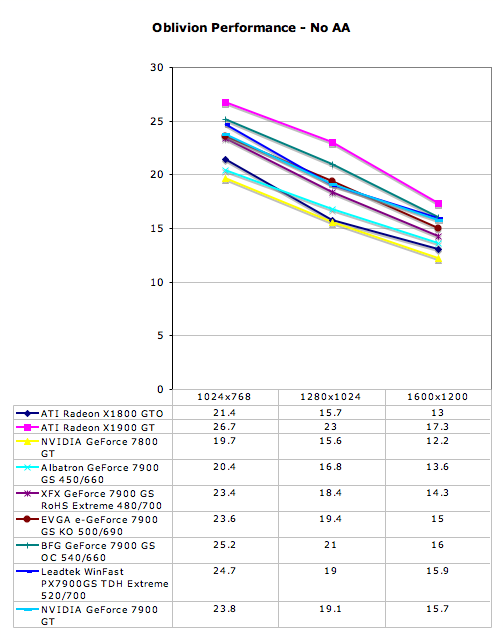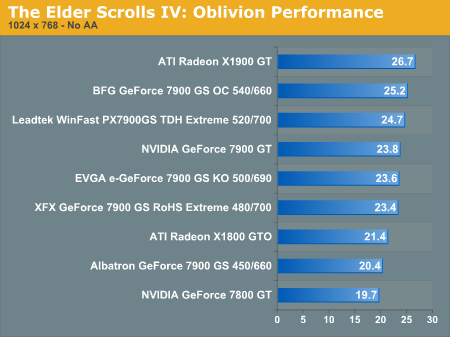The NVIDIA GeForce 7900 GS: A Closer Look
by Josh Venning on September 19, 2006 5:00 AM EST- Posted in
- GPUs
The Elder Scrolls IV: Oblivion
Our third and final benchmark is from The Elder Scrolls IV: Oblivion. This is a fairly recent game which boasts some of the most advanced graphics of any game available to date. Oblivion is one of the most beautiful games we've ever played, and unfortunately it is also one of the most graphically demanding. It can easily put a huge strain on most graphics cards when quality settings are turned up.
We mentioned recently in our silent GPU review that we don't recommend playing Oblivion on a budget or low/midrange graphics card, and we stand by this statement. The game loses a lot of playability without things like Distand Land turned on. This is why we test the game with higher quality settings enabled. Here are the quality settings we used for these test.


For this benchmark, we use FRAPS to measure the average FPS while walking towards an Oblivion gate at night. The margin of error is about 5% for each card, so smaller differences can be ignored. This is one of the more graphically intensive benchmarks we have for this game, and that's why we see such low framerates across the board, even among the faster cards.
This is a game where having a higher clocked 7900 GS is really ideal over a lower clocked one like the Albatron 7900 GS. With a framerate of 25.2 FPS at 1024x768 (which is a very playable resolution for this game), the BFG 7900 GS OC offers much better performance than the 20.4 FPS we see from the Albatron 7900 GS. Considering this, we would recommend either the overclocked BFG or Leadtek 7900 GS to anyone interested in a 7900 GS for playing Oblivion.
Also, because this game tends to favor ATI hardware over NVIDIA, we see that this is one case where the X1900 GT beats out all of the 7900 GS cards in performance in spite of their factory overclocks. If Oblivion is your game of choice and you are looking for a graphics upgrade at around the $200 range, the Connect3D Radeon X1900 GT is available at the time of this writing for $220 and is a good option.
Our third and final benchmark is from The Elder Scrolls IV: Oblivion. This is a fairly recent game which boasts some of the most advanced graphics of any game available to date. Oblivion is one of the most beautiful games we've ever played, and unfortunately it is also one of the most graphically demanding. It can easily put a huge strain on most graphics cards when quality settings are turned up.
We mentioned recently in our silent GPU review that we don't recommend playing Oblivion on a budget or low/midrange graphics card, and we stand by this statement. The game loses a lot of playability without things like Distand Land turned on. This is why we test the game with higher quality settings enabled. Here are the quality settings we used for these test.
| Oblivion Performance Settings | |
| Texture Size | Large |
| Tree Fade | 100% |
| Actor Fade | 100% |
| Item Fade | 66% |
| Object Fade | 90% |
| Grass Distance | 50% |
| View Distance | 100% |
| Distant Land | On |
| Distant Buildings | On |
| Distant Trees | On |
| Interior Shadows | 95% |
| Exterior Shadows | 85% |
| Self Shadows | On |
| Shadows on Grass | On |
| Tree Canopy Shadows | On |
| Shadow Filtering | High |
| Specular Distance | 100% |
| HDR Lighting | On |
| Bloom Lighting | Off |
| Water Detail | High |
| Water Reflections | On |
| Water Ripples | On |
| Window Reflections | On |
| Blood Decals | High |
| Anti-aliasing | Off |


For this benchmark, we use FRAPS to measure the average FPS while walking towards an Oblivion gate at night. The margin of error is about 5% for each card, so smaller differences can be ignored. This is one of the more graphically intensive benchmarks we have for this game, and that's why we see such low framerates across the board, even among the faster cards.
This is a game where having a higher clocked 7900 GS is really ideal over a lower clocked one like the Albatron 7900 GS. With a framerate of 25.2 FPS at 1024x768 (which is a very playable resolution for this game), the BFG 7900 GS OC offers much better performance than the 20.4 FPS we see from the Albatron 7900 GS. Considering this, we would recommend either the overclocked BFG or Leadtek 7900 GS to anyone interested in a 7900 GS for playing Oblivion.
Also, because this game tends to favor ATI hardware over NVIDIA, we see that this is one case where the X1900 GT beats out all of the 7900 GS cards in performance in spite of their factory overclocks. If Oblivion is your game of choice and you are looking for a graphics upgrade at around the $200 range, the Connect3D Radeon X1900 GT is available at the time of this writing for $220 and is a good option.










42 Comments
View All Comments
Josh Venning - Tuesday, September 19, 2006 - link
Thanks for the comment. We didn't include FSAA tests in this article because it isn't a full analysis of 7900 GS performance, but a comparison between different 7900 GS products. For an in-depth look at the 7900 GS performance in more games and settings take a look at the 7900 GS launch coverage(http://www.anandtech.com/video/showdoc.aspx?i=2827...">http://www.anandtech.com/video/showdoc.aspx?i=2827..., and the 7950 GT article which has some 7900 GS SLI numbers (http://www.anandtech.com/video/showdoc.aspx?i=2833...">http://www.anandtech.com/video/showdoc.aspx?i=2833....As far as driver settings, we test with default driver settings with the exception of vsync which is disabled. We do the same with ATI hardware; we leave catalyst AI on its default setting. We find this is the best way to keep our tests consistent for an article like this.
giantpandaman2 - Tuesday, September 19, 2006 - link
I wonder if part of the difference in heat/power consumption had to do with how much power was supplied to the fans. Slow running fan=low power=high heat. Faster fan=higher power=low heat.Meh, I'm not sure a tiny fan could ever put a dent in a 20 watt difference though.